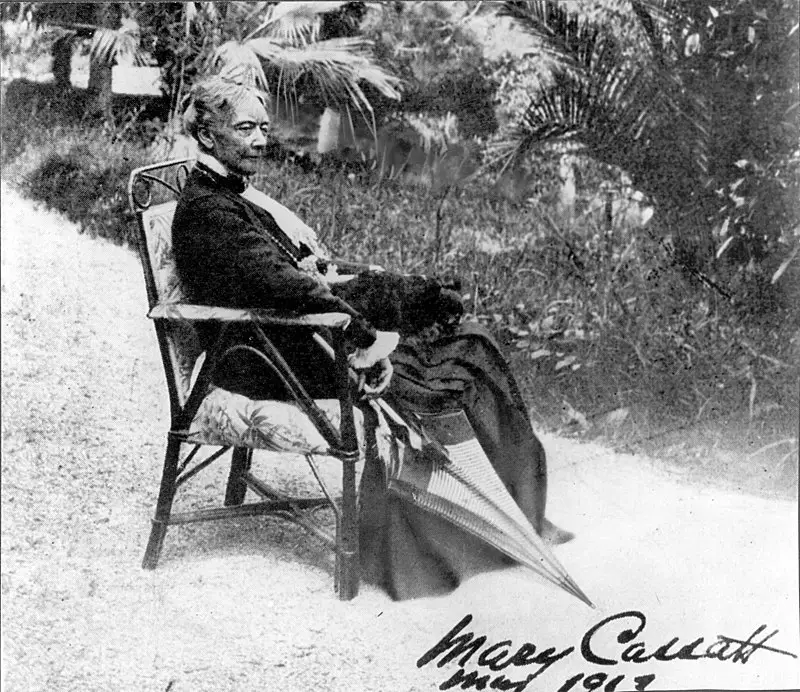Mary Cassatt
Born: 1844
Place of Birth: Pennsylvania
Died: 1926

Mary Cassatt was an American painter during a time in the 1800s when women not only didn’t work, but they weren’t accepted as true artists. Mary was part of the Impressionist movement and was greatly influenced by fellow artist Edgar Degas. While she was discouraged by family, Mary’s contributions to the world of art paved the way for other women to become artists.
- Mary Cassatt was born in 1844 to a well-off family in Pennsylvania. Her family believed in women being prepared as wives and to be mothers and sent her to school for the usual classes such as embroidery, homemaking, sketching, music, and painting. However, it was when the family went to Europe for a few years that Mary began to discover her love of painting.
- The family returned to America and much to her family’s horror, 16 year old Mary signed up for the Academy of Fine Arts in Philadelphia, Pennsylvania. Her time in the school wasn’t pleasant because the male students were mean and patronizing to her. Mary was also disappointed and irritated at the less than adequate course selections and the fact that the curriculum was slow. She made the decision to move to Europe with a focus on studying the original works of the “Old Masters.”
- Mary’s father was disgusted with her choice to move to Paris in 1866, however, it didn’t stop her. She studied in the Louvre with private lessons and copied the masterpieces for two years. She began to be noticed when one of her pieces was chosen for an exhibition operated by the French Government and would be shown at the renowned Paris Salon. To keep her family out of the art world she submitted the work under the name of Mary Stevenson.
- Mary was forced to return to live at home in America with her parents in 1870 when the Franco-Prussian War broke out. The freedom of expression that she had enjoyed in Europe wasn’t available in Philadelphia. She couldn’t locate the kind of supplies that she needed and her father refused to fund anything related to her art. To make money she made a failed attempt to sell some of her works in New York. Her second attempt to sell her paintings in Chicago resulted in a tragic fire that destroyed her work.
- Cassatt’s luck changed when she was contacted by the Pittsburgh archbishop when he wanted to commission her to paint copies by the Italian master Correggio. She headed to Parma, Italy where the originals were on display. The commission money let her continue her painting career and from 1872 through 1874 the Paris Salon accepted her work for their exhibitions. At last she was considered to be an established and accepted artist and she extended her studies to paint in Belgium, Spain, and Rome. She finally settled to live in Paris permanently.
- Most artists question their technique and style and Mary began to experiment, going outside of the standard guidelines of what was sellable. Critics spoke poorly of her new approach using bright colors. She did get encouragement from fellow painter Edgar Degas who was also an inspiration for the impressionist technique. She wrote of his art “It changed my life. I saw art then as I wanted to see it.” Cassatt and Degas developed a strong friendship and her work was exhibited with the 1879 Impressionists and continued through 1881.
- Mary had to take leave of her art when she cared for her sick sister and mother. While her mother came back to health, her sister died in 1882. It was then that Mary returned to her painting. Unlike a lot of the Impressionists of her time, Mary didn’t paint streets and landscapes. Her work was focused on portraits, especially women, mothers and children in everyday life. Her depictions weren’t conventional but showed an honesty of nature. Her work evolved away from Impressionism and took a simpler approach. Although her last exhibition was part of the Impressionists she decided to remove herself from any school or style.
- Cassatt began sponsoring other Impressionists and worked with wealthy patrons to encourage them to support the artists and buy their work. She acted as an advisor to some of those that were collectors but required that if they purchased works they would eventually give them to American art museums.
- Mary developed diabetes and was forced to give up her painting when her eyesight failed. She died in 1926.
Q&A:
What style of painting is Mary Cassatt identified with?
Impressionists
What artist influenced Mary Cassatt’s painting technique?
Edgar Degas
Where was the exhibition that finally established Mary Cassatt as an accepted artist?
Paris Salon
What American art school disappointed Mary Cassatt with both poor courses and slow curriculum?
Academy of Fine Arts in Philadelphia, Pennsylvania
What type of classes did Mary Cassatt’s parents send her to school for?
Embroidery, homemaking, sketching, music, and painting
What forced Mary Cassatt to leave Europe and return to America?
Franco-Prussian War



